KCET 2019 Maths Paper with Solutions
Introduction to KCET 2019 Maths Paper
Detailed Analysis of KCET 2019 Maths Paper
The KCET 2019 Maths paper was a comprehensive test covering a wide range of topics from algebra to calculus. Students found the paper to be moderately difficult, with a balanced distribution of questions from different areas of mathematics. Notable questions included those involving applications of trigonometry, calculus, and geometry. The feedback from students indicated that while some questions were challenging, others were manageable with thorough preparation.
Algebra
One of the key areas in the KCET Maths paper was algebra. Questions ranged from basic algebraic equations to complex polynomial expressions. By applying fundamental algebraic principles, students could effectively solve these questions and arrive at the correct answers.
Trigonometry
Trigonometry questions in the KCET 2019 Maths paper required students to apply trigonometric ratios and identities to solve problems related to angles and triangles. Through a clear understanding of trigonometric concepts, students could navigate through these questions efficiently.
Calculus
Calculus questions tested students’ understanding of differentiation, integration, and their applications. By employing calculus techniques, students could tackle problems involving rates of change, areas under curves, and optimization, among others.
Geometry
Geometry questions encompassed topics such as circles, triangles, and polygons. By utilizing geometric properties and theorems, students could solve problems related to areas, volumes, and angles with precision.
a. x/y
b. x+y
c. x-y
d. y/x
Answer:(d)
Apply log on both sides
log (y1/3x1/2) = log(x+y)5/6
(1/3) log y+(1/2) log x = (5/6) log(x+y)
(1/3y)(dy/dx)+(1/2x) = (5/6(x+y))(1+dy/dx)
(1/3y)(dy/dx)- (5/6(x+y))dy/dx =(5/6(x+y)) -(1/2x)
(dy/dx)[(1/3y)-(5/6(x+y)] = 5x-3(x+y)/6x(x+y)
(dy/dx) = [(2x-3y)/6x(x+y)][6y(x+y)/(2x-3y)]
dy/dx = y/x
Question 2: Rolle’s theorem is not applicable in which one of the following cases?
a. f(x) = x2-4x+5 in [1, 3]
b. f(x) = x2-x in [0, 1]
c. f(x) = x in [-2, 2]
d. f(x) = [x] in [2.5, 2.7]
Answer:(c)
Check option:
Option (a):
(1) f(x) is continuous function in [1, 3]
(2) f(x) is differentiable in (1, 3)
Option (b):
(1) f(x) is continuous function in [0, 1]
(2) f(x) is differentiable in (0, 1)
Option (c):
(1) f(x) is continuous function in [–2, 2]
(2) f(x) is not differentiable at point x = 0 in (–2, 2)
Option (d):
(1) f(x) is continuous function in [2.5, 2.7]
(2) f(x) is differentiable in (2.5, 2.7)
Question 3: The interval in which the function f(x) = x3-6x2+9x+10 is increasing in
a. (-∞,1) ⋃ (3, ∞)
b. (-∞,-1) ⋃ (-3, ∞)
c. [1, 3]
d. (-∞,-1) ⋃ [3, ∞)
Answer:(b)
f(x) = x3-6x2+9x+10
Differentiate with respect to x
f’(x) = 3x2 -12x+9
f’(x) ≥ 0
⇒ 3x2-12x+9 ≥0
⇒ x2-4x+3 ≥ 0
⇒ x2-3x -x+3 ≥ 0
⇒ (x-3) (x-1) ≥ 0

x ∈ (-∞, 1] ⋃[3, ∞ )
Question 4: The side of an equilateral triangle are increasing at the rate of 4cm/sec. The rate at which its area is increasing, when the side is 14 cm
a. 10√3 cm2/sec
b. 14√3 cm2/sec
c. 42 cm2/sec
d. 14 cm2/sec
Answer:(G)
Bonus
Question 5: The value of √24.99 is
a. 4.999
b. 4.899
c. 5.001
d. 4.897
Answer:(a)
f(x) = √x
⇒ dy/dx = 1/2√x
∆y = (dy/dx) ∆x …(i)
Here x = 25 and ∆x = 0.1
∆y = √x-√(x-∆x)
(dy/dx) ∆x = √25-√(25-0.1)
√24.99 = 5-(1/2×5)×0.1
= 5-0.01
= 4.99
Question 6: If 3x-5≤2 then
a. -1≤x≤7/3
b. 1≤x≤7/3
c. 1≤x≤9/3
d. -1≤x≤9/3
Answer:(b)
|3x-5| ≤ 2
⇒ -2 ≤3x–5 ≤ 2
⇒ 3 ≤ 3x ≤ 7
⇒ 1 ≤ x ≤7/3
Question 7: A random variable ‘X’ has the following probability distribution:
| X | 1 | 2 | 3 | 4 | 5 | 6 | 7 |
| P(X) | k-1 | 3k | k | 3k | 3k2 | k2 | k2+k |
a. 1/5
b. -2
c. 2/7
d. 1/10
Answer:(a)
∑P(K)=1
⇒ K-1+3K+K+3K+3K2+K2+K2+K = 1
⇒ 5K2+9K-2 = 0
⇒5K2+10K-K-2 = 0
⇒ (5K-1)(K+2) = 0
5K-1 = 0 or K+2 = 0
K = 1/5 or K = -2 (not possible)
Question 8: If A and B are two events of a sample space S such that P(A) =0.2, P(B) =0.6 and P(AB)=0.5 then P(A’|B)=
a. 3/10
b. 2/3
c. 1/2
d. 1/3
Answer:(c)
Given that
P(A) = 0.2
P(B) = 0.6
P(A|B) = 0.5
Now
P(A’|B) = 1-P(A|B)
= 1-0.5
= 0.5
= 1/2
Question 9: If ‘X’ has a binomial distribution with parameters n = 6, p and P(X = 2) = 12, P(X = 3) = 5 then P=
a. 5/12
b. 16/21
c. ½
d. 5/16
Answer:(G)
Bonus
*G indicates one grace mark
Question 10: A man speaks truth 2 out of 3 times. He picks one of the natural numbers in the set S = {1, 2, 3, 4, 5, 6, 7} and reports that it is even. The probability that it is actually even is
a. 2/5
b. 1/5
c. 1/10
d. 3/5
Answer:(d)
S = {1,2,3,4,5,6,7}
Total probability = 7
P(S1) = Probability of even number = 3/7
P(S2) = Probability of odd number = 4/7
P(ES1) = 2/3
P(ES2) = 1-2/3 = 1/3
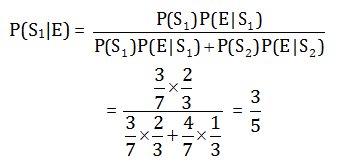
Question 11: If U is the universal set with 100 elements; A and B are two sets such that n(A) = 50, n(B) = 60, n(A⋂B) = 20 then n(A’⋂B’) = ?
a. 40
b. 20
c. 90
d. 10
Answer:(d)
Given that
n(A) = 50
n(B) = 60
n(A⋂B) = 20
Now
n(A’⋂ B’) = P(A⋂B)’
= 100-P(A⋂B)
= 100-[P(A)+P(B)- P(A⋂B)]
= 100-[50+60-20]
= 100-90
= 10
Question 12: The domain of the function f:R→R defined by f(x) = √(x2-x+12)
a. (-∞,3] ⋃[4, ∞)
b. (-∞,3] ⋃(4, ∞)
c. (-∞,3] ⋂ [4, ∞)
d. (3,4)
Answer:(a)
f(x) = √(x2-7x+12)
Now
x2-7x+12≥0
x2-4x-3x+12≥0
(x-4)(x-3) ≥0

x∈(-∞,3] ⋃[4, ∞)
Question 13: If cos x = sin x then, the general solution is
a. x = nπ ± π/4, n∈Z
b. x = 2nπ ± π/4, n∈Z
c. x = nπ+(-1)n π/4, n∈Z
d. x = (2n+1)π ± π/4, n∈Z
Answer:(b)
cos x = |sinx|
Case-1:
cos x = sin x for x∈ [0, π ]
tan x = 1 for x = π/4
Case-2:
s x = -sin x for x ∈ [π, 2π]
tan x = -1 for x∈ 7π/4
Combining both the cases, we get the general is solution 2nπ±π/4
Question 14: √3 cosec 200– sec 200 =
a. 2
b. 3
c. 4
d. 1
Answer:(c)
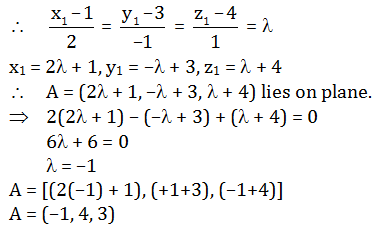
Question 15: If P(n): 2n <n! then the smallest positive integer for which P(n) is true, is
a. 2
b. 3
c. 4
d. 5
Answer:(c)
P(n): 2n< n!
Since
P(1): 2 < 1 is false.
P(2): 22< 2! is false.
P(3): 23< 3! is false.
P(4): 24< 4! is true.
P(5): 25< 5! is true.
So, the smallest positive integer is 4.
Question 16: Foot of the perpendicular drawn from the point (1,3,4) to the plane 2x-y+z+3=0 is
a. (-1,4,3)
b. (0,-4,-7)
c. (1,2,-3)
d. (-3,5,2)
Answer:(a)
The Dr’s of PA are
x1-1, y1-3, z1-4
The Dr’s n are 2, -1, 1
The Dr’s of PA and n are parallel
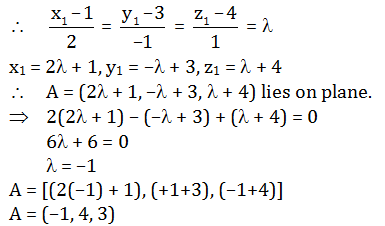
Question 17: Acute angle between the line (x-5)/2 = (y+1)/-1 = (z+4)/1 and the plane 3x-4y-z+5 = 0 is:
a. cos-1(9/√364)
b. sin-1(9/√364)
c. cos-1(5/2√13)
d. sin-1(5/2√13)
Answer:(c)
L: (x-5)/2 = (y+1)/-1 = (z+4)/1
Dr’s of line: 2, -1, 1
P: 3x-4y-z + 5 = 0
Dr’s of normal to plane: -3, 4, 1
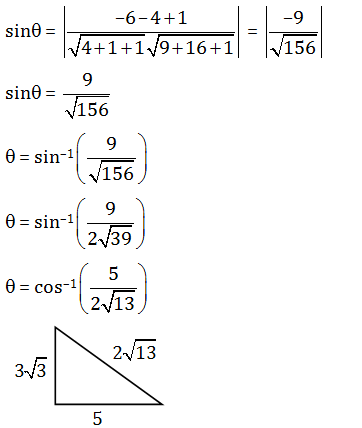
Question 18: The distance of the point (1,2,1) form the line (x-1)/2 = (y-2)/1 = (z-3)/2 is
a. 2√3/5
b. 2√5/3
c. √5/3
d. 20/3
Answer:(b)
Let L: (x-1)/2 = (y-2)/1 = (z-3)/2 = λ
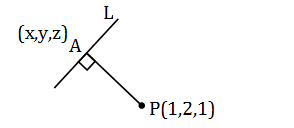
PA→
= Position vector of A – position of vector of P

Vector PA perpendicular to L.
So
PA→.L=0
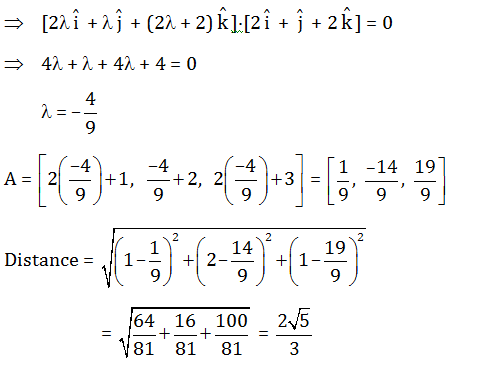
Question 19: XY-plane divides the line joining the points A(2,3,-5) and B(-1,-2,-3) in the ratio
a. 2:1 internally
b. 3:2 externally
c. 5:3 internally
d. 5:3 externally
Answer:(d)
A(2,3,-5), B(-1,-2,-3)
The ratio that xy plane divide line joining the points (x1,y1,z1) and (x2,y2,z2) = -z1:z2
If result is positive, it divides internally otherwise externally.
The ratio that xy plane divides the points (2,3,-5) and (-1,-2,-3)
= -(-5) :(-3)
= -5 : 3
So, 5 : 3 externally in the ratio.
Question 20: The shaded region in the figure is the solution set of the inequations
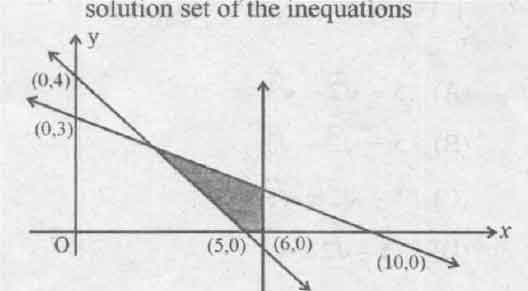
a. 4x+5y≥20, 3x+10y≤30, x≤6, x, y≥0.
b. 4x+5y≥20, 3x+10y≤30, x≥6, x, y≥0.
c. 4x+5y≤20, 3x+10y≤30, x≤6, x, y≥0.
d. 4x+5y≤20, 3x+10y≤30, x≥6, x, y≥0.
Answer:(a)
(1) Since the region lies above the x-axis
So y ≥0
(2) Shaded region is on right side of the y-axis
So x ≥0
(3) Equation of line passing through (5,0) and (0, 4) is
(y-0) = (4/-5) (x-5)
-5y = 4x- 20
4x+5y = 20
(4) Equation of line passing through (10,0) and (0, 3) is
(y-0) = (-3/10) (x-10)
-10y = 3x-30
3x+10y = 30
(5) Shaded region is on left of x = 6.
So x ≤6
Consider the figure and observe the shaded region the inequalities can be written as
x ≥ 0,
y ≥ 0,
x ≤ 6
4x+5y ≥20,
3x+10y ≤ 30
Question 21: The order of the differential equation is
a. 1
b. 2
c. 3
d. 4
Answer:(a)
Differentiate with respect to x
dy/dx =
C1eC2+x+C3eC4+x
dy/dx = y
(dy/dx)-y = 0
Hence the order is 1.
Question 22: If
a. 4
b. 8
c. 16
d. 64
Answer:(d)
Now,
=
= 16×4×1
= 64
Question 23: If the angle between
and
is
2π3
and the projection of
in the direction of
is -2, then
=
a. 4
b. 3
c. 2
d. 1
Answer:(a)
Given angle between
and
is
2π3
And
⇒
⇒
⇒
⇒
Question 24: A unit vector perpendicular to the plane containing the vectors
a.
b.
c.
d.
Answer:(c)
The vector which is perpendicular to two vectors is given by the cross product of the two vectors.
=
Unit vector perpendicular to P and Q is given by
=
=
Question 25:
a. 0
b.
c.
d.
Answer:(d)
=
=
=
=
Question 26:
∫−33cot−1xdx=
a. 3π
b. 0
c. 6π
d. 3
Answer:(a)
Let I =
∫−33cot−1xdx
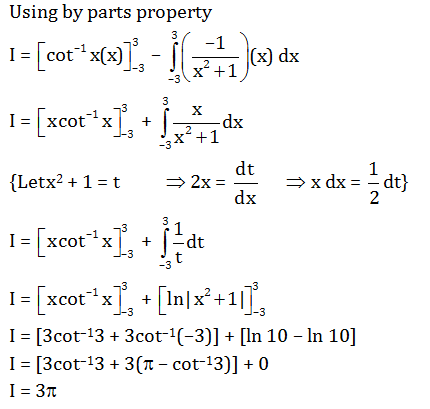
Question 26:
∫−33cot−1xdx=
a. 3π
b. 0
c. 6π
d. 3
Answer:(a)
Let I =
∫−33cot−1xdx
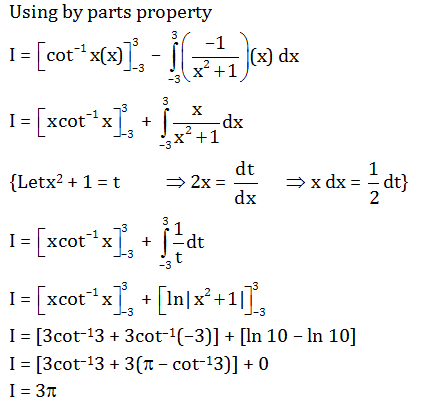
Question 27:
∫1x+xxdx=
a. 2 log (√x+1)+C
b. (½) tan-1√x+C
c. tan-1√x+C
d. 2 tan-1√x+C
Answer:(d)
Let I =
∫1x+xxdx
∫1x(x+1)dx
Let √x = t
x = t2
dx = 2t dt
So I =
∫1t(1+t2)2tdt
I =
2∫1(1+t2)dt
= 2 tan-1t +C
= 2 tan-1√x+C
Question 28:
∫2x−1(x−1)(x+2)(x−3)dx=Alog|x−1|+Blog|x+2|+Clog|x−3|+K
, then A, B, C are respectively:
a. -1/6, 1/3, -1/2
b. 1/6, 1/3, -1/5
c. 1/6, -1/3, 1/3
d. -1/6, -1/3, 1/2
Answer:(d)
Let I =
∫2x−1(x−1)(x+2)(x−3)dx
Now,
(2x-1)/(x-1)(x+2)(x-3) = (A/(x-1) )+(B/(x+2))+(C/(x-3))
2x-1 = A(x+2)(x-3)+B(x-1)(x-3)+C(x -1)(x+2)
Putting x = 3, we get
6 -1 = C(3-1)(3+2)
C = ½
Putting x = 1, we get
2-1 = A(1+2)(1-3)
A = -1/6
Putting x = -2, we get
-4-1 = B(-2-1)(-2-3)
B = -1/3
A.B,C are -1/6, -1/3, 1/2.
Question 29:
∫02[x2]dx=
a. 5-√2-√3
b. 5+√2-√3
c. 5-√2+√3
d. -5-√2-√3
Answer:(a)
Let I =
∫02[x2]dx

I = (√2-1)+2(√3-√2)+3(2-√3)
= √2-1+2√3-2√2+6-3√3
= 5-√2-√3
 = (π/2)-0-(0-1)= (π/2)+1
= (π/2)-0-(0-1)= (π/2)+1Question 31: If α and β are the roots of the equation x2+x+1 = 0 then α2+β2 is:>
a. 1
b. (-1+i√3)/2
c. (-1-i√3)/2
d. -1
Answer:(d)
Given equation is x2+x+1 = 0
α+β = -1
αβ = 1
Now, α2+β2 = (α+β)2-2αβ
= (-1)2-2(1)
= 1-2
= -1
Question 32: The number of 4-digit numbers without repetition that can be formed using the digits 1,2,3,4,5,6,7 in which each number has two odd digits and two even digits is
a. 432
b. 436
c. 450
d. 454
Answer:(a)
Given digits are 1, 2, 3, 4, 5, 6, 7
Two even digits can be selected in 3C2
Two odd digits can be selected in 4C2 ways
These selected 4 digits can be arranged in 4! ways
The total number of ways = 4C2 ×3C2 ×4!
= 6×3×24
= 432
Question 33: The number of terms in the expansion of (x2+y2)25-(x2-y2)25 after simplification is
a. 0
b. 13
c. 26
d. 50
Answer:(b)
(x2+y2)25-(x2-y2)25
(a+b)n-(a-b)n if n is odd
On simplification we get (n+1)/2 terms
i.e. (25+1)/2 = 26/2
= 13
Question 33: The number of terms in the expansion of (x2+y2)25-(x2-y2)25 after simplification is
a. 0
b. 13
c. 26
d. 50
Answer:(b)
(x2+y2)25-(x2-y2)25
(a+b)n-(a-b)n if n is odd
On simplification we get (n+1)/2 terms
i.e. (25+1)/2 = 26/2
= 13
Question 34: The third term of a G.P. is 9. The product of its first five terms i
a. 35
b. 39
c. 310
d. 312
Answer:(c)
The third term of G.P. is 9
a.2 = 9
Now, the product of five terms = T1T2T3T4T5
= (a)(ar)(ar2)(ar3)(ar4)
= a5r10
= (ar2)5
= (9)5
= 310
Question 35: A line cuts off equal intercepts on the co-ordinate axes. The angle made by this line with the positive direction of X-axis is
a. 450
b. 900
c. 1200
d. 1350
Answer:(d)
We know that equation of a line in intercept form is
(x/a)+(y/b) = 1
Here, both intercept are equal
So (x/a)+(y/a) = 1
y = –x+a
Now comparing it with
y = mx + c
We get m = -1 = slope
We know that
Slope = tan θ
tan θ = -1
θ = 1350
Question 36:.
∫x3sin3xdx=

Answer:(c)
Let I =
∫x3sin3xdx
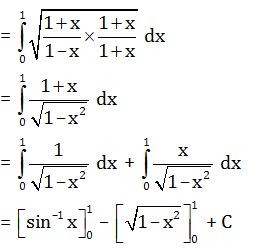
Question 37: The area of the region above X-axis included between the parabola y2= x and the circle x2+y2 = 2x in square units is
a. (π/4)-(3/2)
b. (3/2)-( π/4)
c. (2/3)-( π/4)
d. (π/4)-(2/3)
Answer:(d)
y2 = x …(1)
x2+ y2 = 2x…(2)
(x-1)2 +(y-0)2 = 1
Equation (2) is a circle with centre (1, 0) and radius 1.
Solving eq.(1) and eq.(2)
(x-1)2 + x = 1
x2-x = 0
x(x-1) = 0
x = 0, 1
We get the points of intersection (0, 0) and (1, 1)
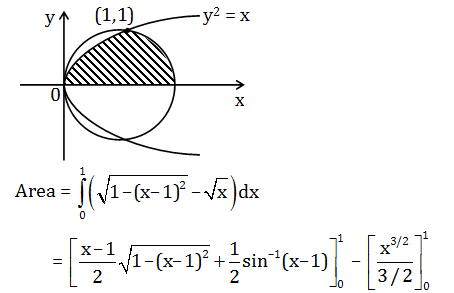
= [0+ π/4]-(2/3)
= (-2/3)+( π/4)
Question 38: The area of the region bounded by Y-axis, y = cos x and y = sin x; 0 ≤x≤π/2 is
a. √2-1 Sq. units
b. √2 Sq. units
c. √2+1 sq. units
d. 2-√2 Sq. units
Answer:(a)
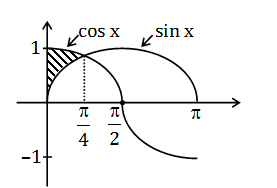
Required area =
∫0π4(cosx−sinx)dx
=
[cosx−sinx]0π4
= (1/√2)+(1/√2)-1)
= (√2-1) Sq. units
Question 39: The integrating factor of the differential equation (2x+3y2)dy = y dx (y > 0) is
a. e1/y
b. -1/y2
c. 1/x
d. 1/y2
Answer:(d)
(2x+3y2)dy = y dx
(2x+3y2)/y = dx/dy
(dx/dy)-(2/y)x = 3y
I.F =
e∫−2ydy
= e-2 log y
= y-2
= 1/y2
Question 40: The equation of the curve passing through the point (1,1) such that the slope of the tangent at any point (x,y) is equal to the product of its coordinates is
a. 2 log x = y2-1
b. 2 log y = x2+1
c. 2 log y = x2-1
d. 2 log x = y2+1
Answer:(c)
(dy/dx) = xy
(1/y)dy = x dx
Integrate
log y = (x2/2)+C ..(i)
Equation (i) passing through (1,2)
log(1) = (12/2)+C
C = -1/2
Put in (i)
log y = (x2/2)-(1/2)
2 log y = x2-1
Question 41: The eccentricity of the ellipse 9x2+25y2 = 225 is
a. 4/5
b. 3/5
c. ¾
d. 9/16
Answer:(a)
9x2+25y2 = 225
(x2/52)+(y2/32) = 1
Eccentricity (e) = √(a2-b2)/a
= √(25-9)/5
= 4/5
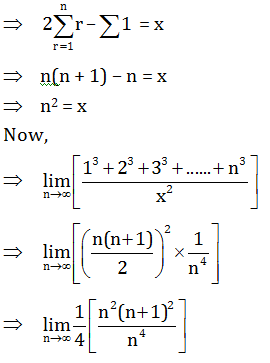 = (1/4)×1= 1/4
= (1/4)×1= 1/4 Question 43: The negation of the statement ”All continuous functions are differentiable.”
a. All continuous functions are not differentiable
b. Some continuous functions are differentiable.
c. Some continuous functions are not differentiable.
d. All differentiable functions are continuous.
Answer:(c)
Always all differentiable functions are continuous. But all continuous functions are not differentiable. So, negation of the given statement is some continuous functions are not differentiable. Ex: |x|
Question 44: Mean and standard deviation of 100 items are 50 and 4 respectively. The sum of all squares of the items is
a. 251600
b. 256100
c. 266000
d. 261600
Answer:(a)
Here n = 100
A = 50
σ = 4
Now A = Σx/n
Σx = An
Σx = 100×50
= 5000
Again from the formula,
σ2+A2 = Σx2/n
Σx2 = n(σ2+A2)
= 100(16+2500)
= 251600
Question 45: Two letters are chosen from the letters of the word ‘EQUATIONS’. The probability that one is vowel and the other is consonant is
a. 8/9
b. 4/9
c. 3/9
d. 5/9
Answer:(d)
Vowel: E, A, U, I, O ⇒ P(v) = 5C1
Consonant: Q, T, N, S ⇒ P(c) = 4C1
Probability = 5C1 × 4C1/9C2
= 5×4/36
= 20/36
= 5/9
Question 46: The constant term in the expansion of
|3x+12x−1x+25x−13x+2x+17x−23x+14x−1|
is:
a. 0
b. 2
c. -10
d. 6
Answer:(d)
Δ=|3x+12x−1x+25x−13x+2x+17x−23x+14x−1|
Put x = 0
Δ=|1−12−121−21−1|
Δ
= 1(-3)+1(3)+2(-1+4)
= -3+3+6
= 6
Question 47: If [x] represents the greatest integer function and f(x) = x-[x]-cos x then f’(π/2) =
a. 0
b. 1
c. 2
d. does not exist
Answer:(c)
f(x) = x-[x]-cos x
since x = [x]+{x}
f(x) = {x}-cos x
f’(x) = 1+sin x
f’(π/2) = 1+ sin (π/2)
= 1+1
= 2
Question 48: If

continuous at x=0, then k=
a. 3/2
b. 9/5
c. 1/2
d. 2/3
Answer:(G)
Bonus
*G indicates one grace mark
Question 49: If f(x) = sin-1[(2x+1 )/(1+4x)], then f’(0) =
a. 2 log 2
b. log 2
c. (2 log 2)/5
d. (4 log 2)/5
Answer:(b)
f(x) = sin-1[(2x+1 )/(1+4x)]
= sin-1[(2×2x)/(1+(2x)2)]
= 2 tan-1(2x)
Differentiating w.r.t.x
f’(x) = (2/(1+4x))(2x log 2)
f’(0) = (2/(1+1)) log 2
f’(0) = log 2
Question 50: If x = a sec2 θ, y = a tan2 θ then d2y/dx2 =
a. 2a
b. 1
c. 0
d. 4
Answer:(c)
x = a sec2 θ
y = a tan2 θ
y = a(sec2 θ-1)
y = a(x-1)
dy/dx = a
d2y/dx2 = 0
Question 51: The inverse of the matrix
[250011−103]
is:
a.[3−11−156−55−22]
b.[3−55−1−6−21−52]
c.[3−155−16−21−52]
d.[3−155−16−21−5−2]
Answer:(c)
Let A =
[250011−103]
|A|=2(3−0)−5(0+1)+0
= 1
A-1= adj A/|A|
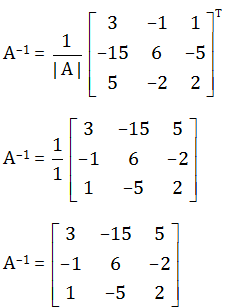
Question 52: If P and Q are symmetric matrices of the same order then PQ-QP is
a. Identity matrix
b. Symmetric matrix
c. zero matrix
d. Skew symmetric matrix
Answer:(d)
Given P = P’ and Q = Q’
Now,
(PQ-QP)’ = (PQ)’-(QP)’
= Q’P’-P’Q’
= QP-PQ
= -[PQ-QP]
So (PQ-QP) is skew-symmetric.
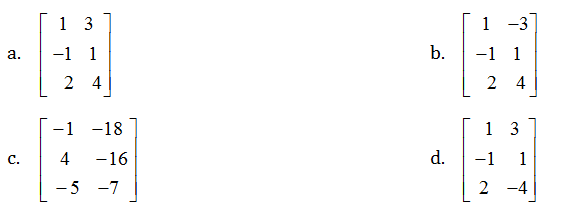 Answer:(a)3A+4B’ =
Answer:(a)3A+4B’ =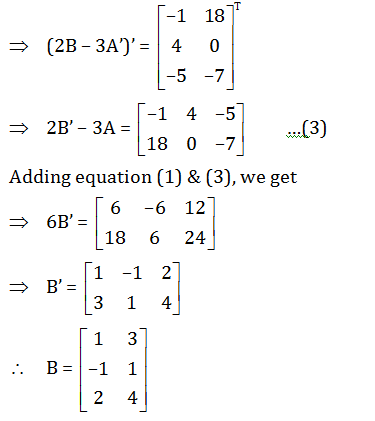
Question 54: If A =
[1342]
, B =
[2−112]
, then |ABB’|=
a. 50
b. -250
c. 100
d. 250
Answer:(b)
A =
[1342]
B =
[2−112]
B’ =
[21−12]
Now, |ABB’| = |A| |B| |B’|

= (2-12)(4+1)(4+1)
= -10×5×5
= -250
Question 55: If the value of a third-order determinant is 16, then the value of the determinant formed by replacing each of its elements by its cofactor is
a. 96
b. 48
c. 256
d. 16
Answer:(c)
Given that |A| = 16
Order of determinant A = 3
Now, |adj A| = |A|2
= 162
= 256
Question 56:
f:R→R
and
g:[0,∞)→R
is defined by f(x) = x2 and g(x) = √x. Which one of the following is not true ?
a. gof (4) = 4
b. fog (-4) = 4
c. fog (2) = 2
d. gof (-2) = 2
Answer:(b)
f(x) = x2
g(x) = √x
Now,
fog(x) = f[g(x)]
= f[√x ]
= x
fog(2) = 2
fog(-4) = -4
And
gof(x) = g[f(x)]
gof(x) = g[x2]
gof(-2) = g(4)
= √4
= 2
Question 57: A = {x|x∈N, x ≤5}, B = {x|x∈Z, x2-5x+6 = 0}, then the number of onto functions from A to B is
a. 2
b. 23
c. 30
d. 32
Answer:(c)
A = {x|x∈N, x ≤5}
A = {1,2,3,4,5}
B = {x|x∈Z, x2-5x+6 = 0}
B = {2,3}

= (5+10)×2
= 30
Question 58: On the set of positive rationals, a binary operation * is defined by a*b = 2ab/5 . If 2*x = 3-1, then x =
a. 1/6
b. 5/12
c. 2/5
d. 125/48
Answer:(b)
Given condition
a*b = 2ab/5
Now,
2*x = 3-1
2(2x)/5= 1/3
4x = 5/3
x = 5/12
Question 59: cos[2 sin-1 (3/4)+cos-1(3/4)] =
a. -3/4
b. 3/4
c. 3/5
d. does not exist
Answer:(a)
cos[2 sin-1 (3/4)+cos-1(3/4)] = cos [2 sin-1(3/4)+cos-1(3/4)]
= cos [sin-1(3/4)+ sin-1(3/4)+cos-1(3/4)]
= cos [(π/2)+sin-1(3/4)]
= -sin(sin-1(3/4)
= -3/4
Question 60: If a+ π/2 <2 tan-1x+3 cot-1x<b then ‘a’ and ‘b’ are respectively:
a. 0 and π
b. π/2 and 2π
c. 0 and 2π
d. -π/2 and π/2
Answer:(b)
We know that 0 < cot-1x < π
⇒ π+0<2 (π/2)+ cot-1x < π+ π
⇒ π<2(tan-1x+cot-1x)+cot-1x<2π
⇒ π<2tan-1x+3cot-1x<2π ..(1)
compare equation (1) to a+ π/2 <2 tan-1x+3 cot-1x<b
a = π/2
b = 2π
Request call back
- KCET 2019 Physics Paper with Solutions
- KCET 2019 Chemistry Paper with Solutions
- KCET 2019 Maths Paper with Solutions
- KCET 2019 Biology Paper with Solutions
- KCET 2020 Chemistry Paper with Solutions
- KCET 2020 Physics Paper
- KCET 2020 Biology Paper with Solutions
- KCET 2020 Mathematics Questions Paper
- KCET Biology Examination 2021 Paper
- KCET – 2021 TEST PAPER
- IISER MOCK TEST – 4
- IISER MOCK TEST – 3
- IISER MOCK TEST – 2
- IISER MOCK TEST – 1
- KCET Mathematics- 2021 Test Paper
- KCET Chemistry – 2021 TEST PAPER
- KCET Physical – 2021 TEST PAPER
- KCET Biology Examination 2021 Paper
- KCET 2020 Mathematics Questions Paper
- KCET 2020 Biology Paper with Solutions
- KCET 2020 Physics Paper
- KCET 2020 Chemistry Paper with Solutions
- KCET 2019 Biology Paper with Solutions
- KCET 2019 Chemistry Paper with Solutions
- KCET 2019 Maths Paper with Solutions
